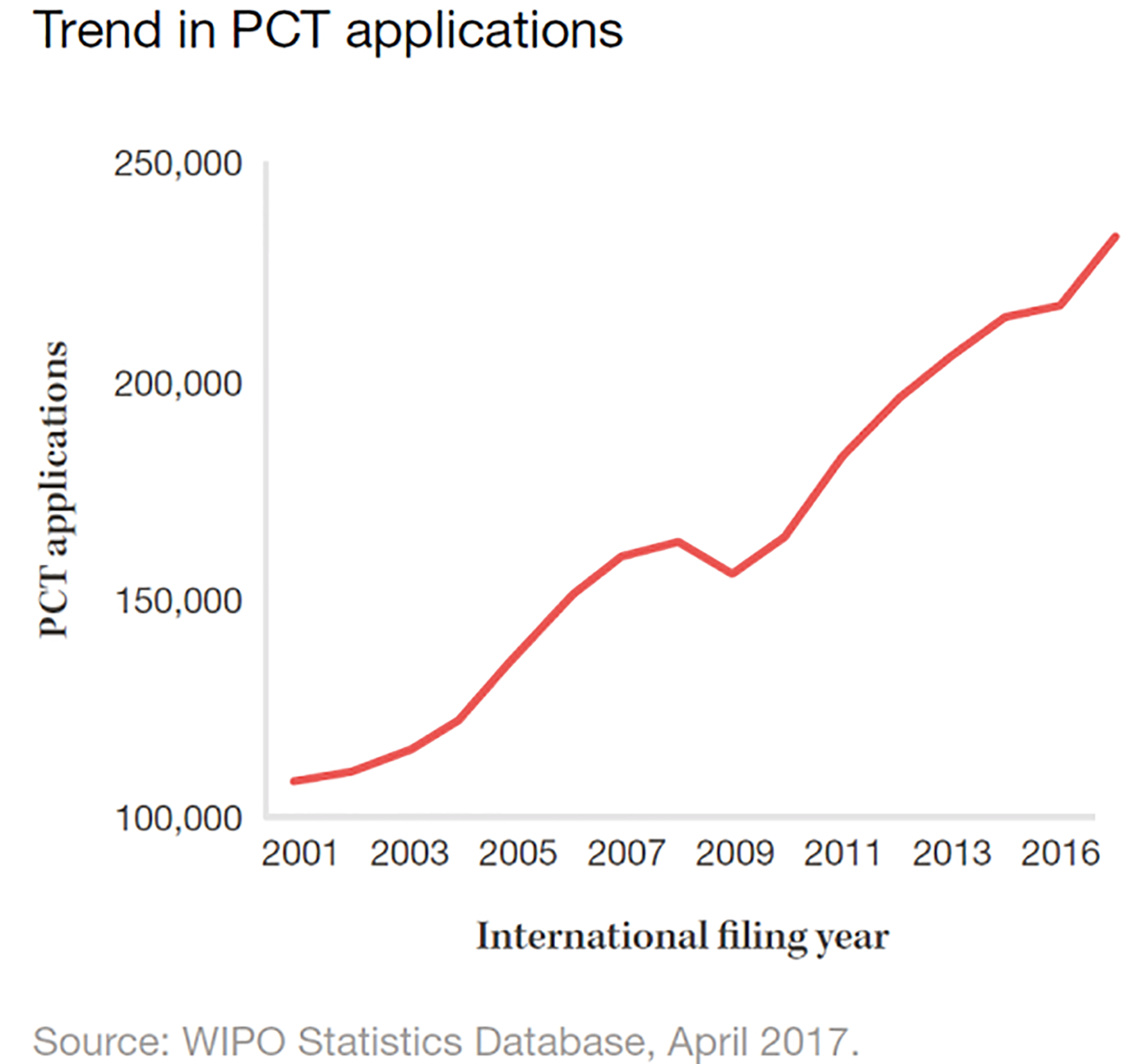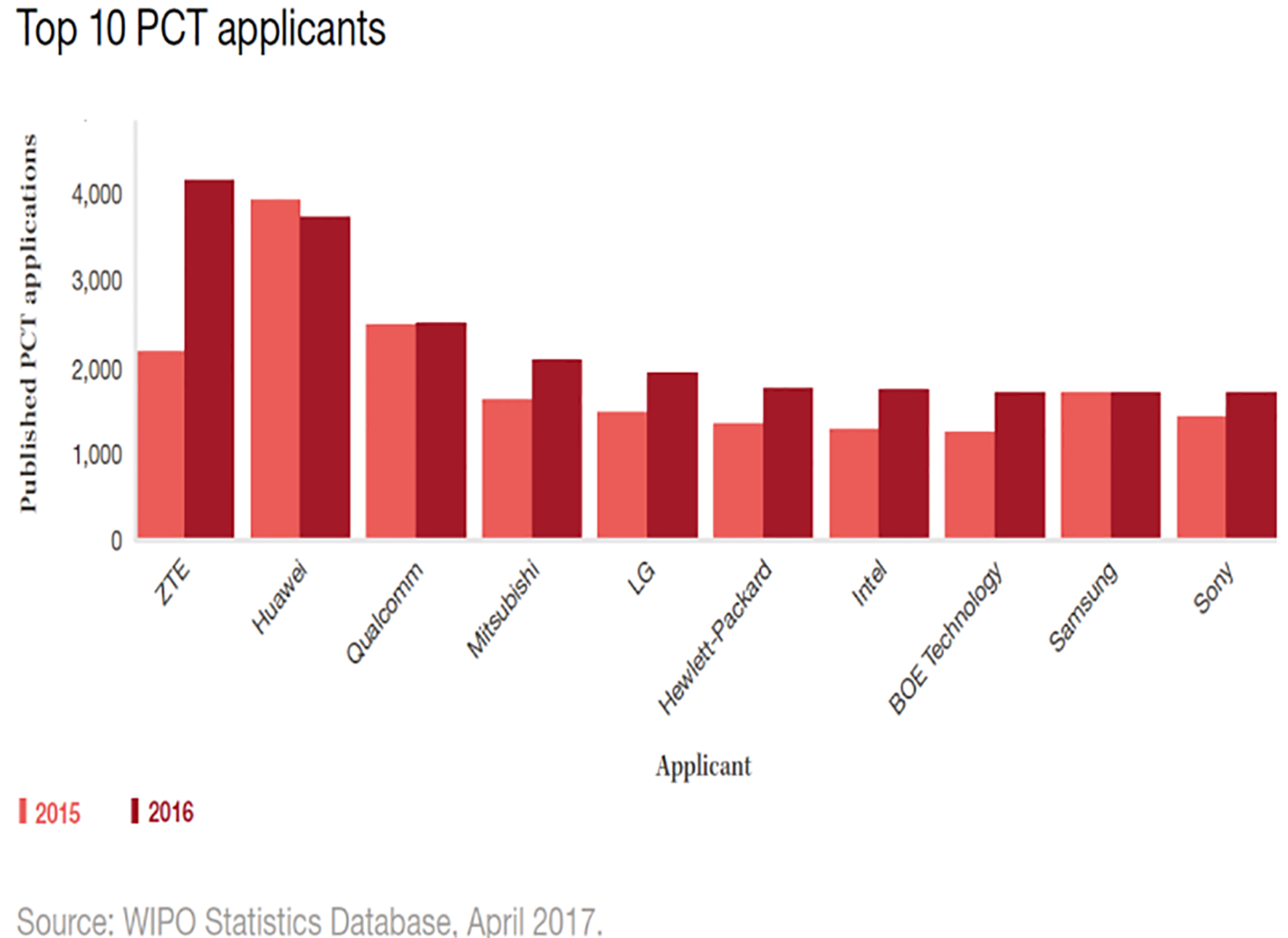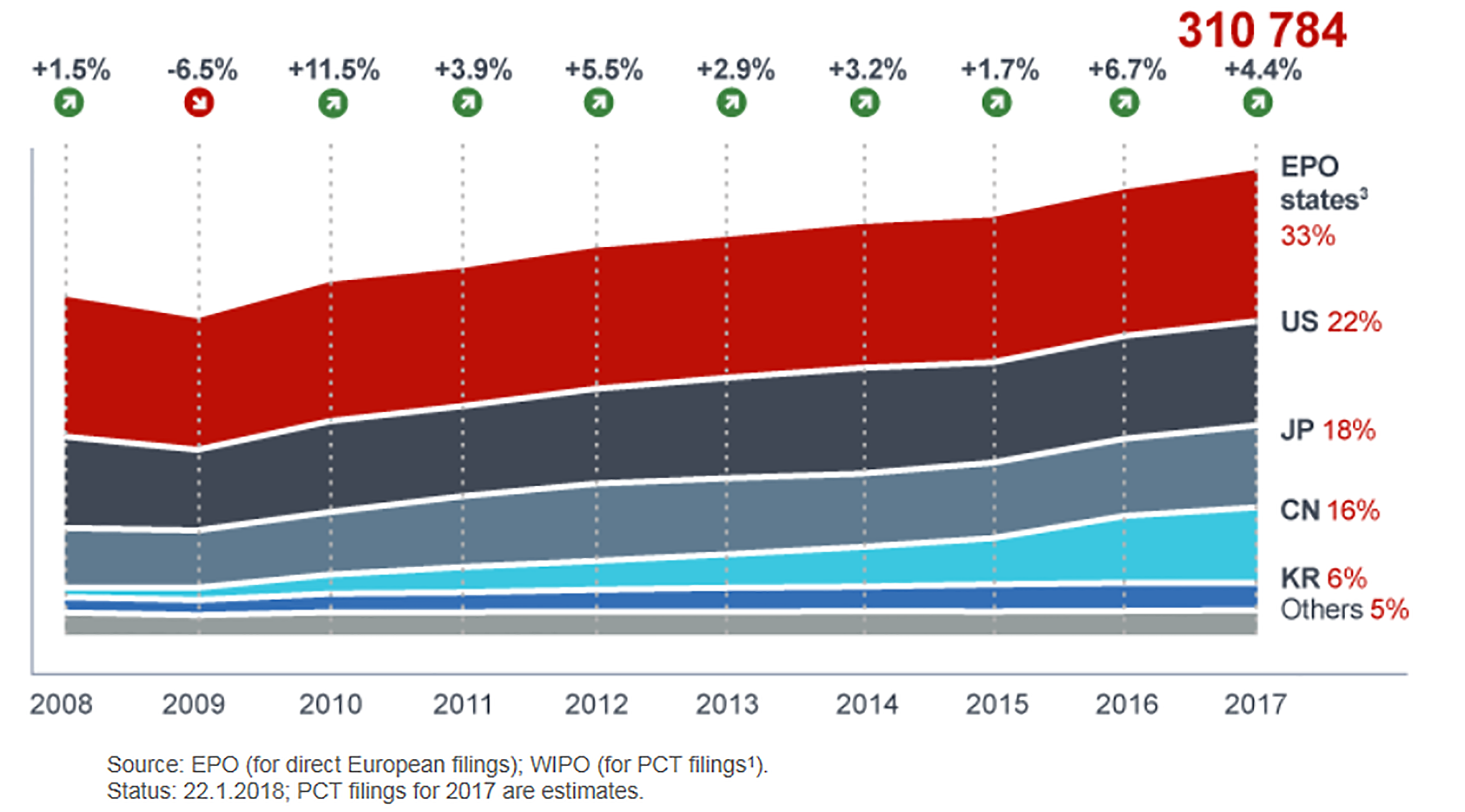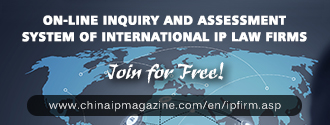Statistics trends
PCT: With exception of 2009 patent applications in agreement with an international trend increased year over year as shown in the graphic below. The trend is accentuated in China with the record filing of 1.300.000 patents in 2017.
Trend in PCT applications

Top 10 PCT applicants

Patent filings come mainly from highly developed countries, such as US and Europe, counting nearly forhalf of the filings. Nearly another half comes from Asian countries. Two Chinese companies, Shenzhen- based ZTE and Huawei Technologies were the largest PCT applicants already in 2016. Digital communication was the most frequently featured technology field in PCT applications, followed by computer technology, electrical machinery and medical technology.
EPC: In line with the PCT system, patent filings also increased for the EPC year over year. The following graph shows the development over the last 10 years, indicating the geographic origin of the European patent filings:

EPO top applicants 2017
Company | Country | No. of filings |
HUAWEI | CN | 2398 |
SIEMENS | DE | 2220 |
LG | KR | 2056 |
SAMSUNG | KR | 2016 |
QUALCOMM | US | 1854 |
ROYAL PHILIPS | NL | 1733 |
UNITED TECHNOLOGIES | US | 1719 |
INTEL | US | 1435 |
ROBERT BOSCH | DE | 1412 |
ERICSSON | SE | 1373 |
Strategic consideration
Patents are territorial rights. The existing systems, nationally or regionally, have an overlapping territorial scope and they co-exist. It is up to the applicant to choose the scope of protection which is the most convenient for it. The first consideration for the applicant is therefore the question where, in which country(ies) or in which region(s), it wants to protect its patent, meaning where the patent can be used to its full potential.
The applicant can apply through WIPO' s PCT system, among others, also to EPO's PCT to designate PCT member states. In case of conflicts between the provisions of the EPC and those of the PCT, the PCT prevails. EPO can function as International Authority (examining body) for the PCT. As from the entry into force of EPC 2000 on 13 December 2007 the EPO has withdrawn all notifications of incompatibility with PCT provisions.
The PCT provides a unified procedure for filing patent application globally, at a wider scope than the EPC. However, PCT does not provide a unified examination system. The advantage of the EPC system is however that the EPC application will be reviewed and examined centrally by EPO following EPC regulations and the applicant get search reports on prior art. In both systems it is up to the corresponding national or regional body to validate and issue the national patent certificate, the patent owner has to renew its patent with the national office and enforce its patents in the national courts.
The priority right protection under a PCT application is 30 months starting from the application date or an earlier priority date, which gives the applicant more time to consider relevant market factors before deciding whether and in which countries to apply for patent rights. In addition, in case of a PCT application, the applicant does not need to pay the official fees and relevant cost (such as translation) until the application enters into the respective examination procedure of the designated countries.
Upon filing, the applicant shall designate the EPC countries where patent protection is sought. In practice, most of the applicants would first include all EPC countries in the application and determine the exact scope of patent protection at a later stage.
Outlook: unitary patent system
According to the European Commission, the average cost of a US patent is just 1,850 USD, whereas it can cost more than 32,000 EUR in translation and other costs to obtain an Europe-wide patent. The Unitary Patent system would bring the costs for the latter down. It consists of two blocks, the Unitary Patent and the Unified Patent Court (UPC).
Unitary Patents are patents granted by the EPO under the rules and procedures of the EPC unitary effect is given for the territory of the Member States participating in the Unitary Patent system. As the system is built on European patents granted by the
EPO under the rules of the European Patent Convention (EPC), nothing will change in the pre-grant phase and the same standards of quality search and examination will apply. After an European patent is granted, the patent proprietor will be able to request unitary effect, thereby getting a unitary patent which provides uniform patent protection in up to 26 EU Member States (all EU Member States except Croatia and Spain, Poland being still a question mark).
The Unified Patent Court (UPC) is an international court set up by participating EU Member States to deal with the infringement and validity of both Unitary Patents and European patents, putting an end to costly parallel litigation and enhancing legal certainty. The new UPC system foresees a Europe- wide court system to ensure that businesses are not forced to travel far to resolve disputes over UPC patents. The system includes central, regional and local courts. The seats for the central UPC courts are, according to current plans, London, Paris and Munich – each with their own specialist matter. The London court will specialize in resolving patent disputes in the field of life sciences, whereas major technology patent disputes will be heard in Paris. The UPC's central division in Munich will be competent in disputes over mechanical engineering patents. A UPC Appeal Court is foreseen to be in Luxembourg. European patents will be subject to the UPC's jurisdiction unless owners 'opt out' those patents. Where those patents are opted out, disputes over their validity or infringement will be heard before national courts as it is currently the case.
"European patents" must be validated and maintained individually in each country where they take effect. This is a complex process; the validation requirements differ between countries and can lead to high direct and indirect costs, including translation costs as indicated previously. Unitary Patents will remove the need for complex and costly national validation procedures and only one renewal proceedings will be necessary. One drawback of the system could be that the unitary patent can be subject to a central attack. If such invalidation proceedings is successful, the patent holder would be left with no patent at all, unless it took the precaution to protect the patent otherwise, e.g. through national protection. This could be especially critical for so-called blockbuster or crown-jewel patents. On the other hand, the prospect of a pan EU interim injunction against an alleged infringer may be attractive. Life sciences companies, both originator and generic, are likely to want to have some input in shaping the jurisprudence in this area.
The EU regulations establishing the Unitary Patent system (No. 1257/2012 and No. 1260/2012) entered into force in January 2013. They will however only apply as from the date of entry into force of the UPC Agreement, that is, after four months following the ratification process (mandatorily including those of France, Germany and the United Kingdom). The German ratification process has been currently held up by a legal challenge before the country's Constitutional Court which could be solved in 2019.
Final note: BREXIT
UK is supposed to leave the European Union in March 2019.This has however no implication for the "European Patent" being it not a European Union right. UK will participate in the EPC independently on its membership or not of the European Union.
The new European patent system is a complex mixture of EU and non-EU components. Although the UPC agreement is governed by an international treaty outside the EU, it was set up under the EU auspices and a unitary patent is established by EU regulations. Beside that UK has ratified in April 2018 the international agreement to set up a Unified Patent Court for Europe. Thus, despite the BREXIT UK is expected be part of the Unitary Patent.
1. According to Article 55 EPC disclosures of the invention within six months preceding the filing of the European patent application and due to or in consequence of (1) an evident abuse in relation to the applicant or legal predecessor (unauthorized disclosure), or display of the invention by the applicant or legal predecessor at certain official or officially recognized international exhibitions are not novelty-destroying.
2. Article 52(2)(c) and (3) EPC. Similar rules exist in China: Software inventions that comprise only rules and methods for intellectual activities are not patentable. However, software inventions that comprise both rules and methods for intellectual activities and technical features (ie, the invention uses technical means in order to solve technical problems and obtain technical effects) can be patented.
3. China has no opposition procedure. The validity of a granted patent can be challenged by filing an invalidation application with the Patent Review Board, which is a separate body from the courts. A patent can be invalidated on the following limited grounds:
• Confidentiality examination requirements for inventions made in China were not satisfied before filing of the patent outside China.
• There is a lack of novelty, inventiveness or usefulness.
• There was insufficient disclosure.
• The description does not support the claims.
• Amendments to the patent application documents exceed the original scope.
• Independent claims fail to state the essential technical features of the solution to the technical problem.
4. In China an applicant can appeal a Patent Office decision to the Patent Review Board. If the applicant disagrees with the Patent Review Board’s decision, it can appeal by filing an administrative litigation with a People’s Court.
5. European patent filings include direct European filings under the European Patent Convention (EPC) and international filings under the Patent Cooperation Treaty (PCT).










